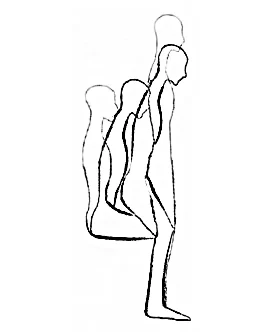Notes After a Few Lessons
A More Detailed Explanation of the Alexander Technique
1. We each develop our own way of sitting, standing, walking, speaking, etc. – our own individual way of ‘using’ our body, or our ‘use’.
2. The way we use our bodies affects how well our bodies can function.
This happens in the immediate…
If I tense my throat when speaking, it affects my vocal cords and hence my voice. If I tense my arms and raise my shoulders when playing flute, it affects control of my fingers and hence my playing.]
…and it happens in the longer term.
The way we use our bodies affects the posture we grow into, and the posture we grow into effects how well our bodies can function. If we regularly slump, we gradually grow into a slumped posture. And If we have grown into a slumped posture, this compresses and distorts our spine, amongst other things]
So:
Use affects function – if we use our bodies poorly, they will not work well. To learn to use our bodies better we need to consider two more points.

3. Our feelings are unreliable.
[If we have been slumping for many years, our slumped posture will have come to feel normal. This means that any change from our old, usual posture will feel different and possibly even wrong. Our feelings will tend to guide us back to our old, usual posture, making it harder to adopt a different and better posture which will feel different (and possibly even wrong) at first.]
4. The right thing does itself.
[We are designed to be easily upright. A comfortable, upright posture should be our natural condition, but most of us develop habits which interfere with this. Rather than slumping and collapsing, or trying to hold ourselves up stiffly and rigidly, we need to stop interfering and allow our natural, upright posture to return. ]
So, improving our use isn’t simply a matter of being told what posture to be in. We may think we are in the ‘correct’ posture but we cannot rely on our feelings to judge this. Also, as our old ways of doing things will feel familiar and ‘normal’, our feelings will lead us back to these old habits. So even though the old ways may feel normal and ok, they may be damaging for us.
And good use doesn’t mean holding ourselves up stiffly, as this is simply making too much tension. To allow our postural muscles to work for us, we need to stop doing the things which interfere with their ability to hold us upright. If we can learn to stop holding our bodies in a distorted way (whether this is slumping or being too rigid) then our postural muscles can engage naturally and hold us up easily, comfortably and at our natural height. Then, the right thing can do itself, and our bodies can work as efficiently as possible.